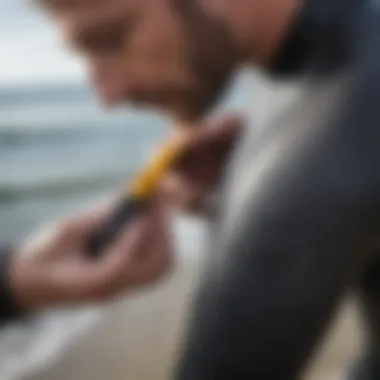Essential Wetsuit Repair Tape Guide for Enthusiasts


Intro
When the sun rises and the waves beckon, nothing is more liberating than slipping into a wetsuit, ready for an adventure. But what happens when that trusty suit gets a tear? The good news, for those passionate about watersports, is that wetsuit repair tape can restore your gear, extending its life and saving you money. It’s a simple solution that can make a world of difference, whether you’re a surfer catching the next big wave or a paddleboarder gliding over serene waters.
Understanding wetsuit repair tape isn’t just a matter of knowing it exists; it’s about recognizing its role in maintaining the gear you rely on. With the right information, you can effortlessly patch up small rips or larger damage without needing professional repairs, allowing you to spend more time enjoying your time on the water. This guide aims to unveil the scope of wetsuit repair tape—its applications, types, and effectiveness—ensuring you’re well-equipped to tackle any wetsuit mishap.
In a world where every minute counts in the water, knowing how to manage your equipment can set you apart. This guide offers insights tailored for surfers, paddleboarders, kitesurfers, instructors, and gear reviewers, making it a critical resource to enhance your understanding of wetsuit maintenance and care.
Understanding Wetsuit Repair Tape
When water sports enthusiasts hit the waves, they rely on their wetsuits for protection against the elements. However, the wear and tear on these suits can be pretty significant. That's where wetsuit repair tape comes into play. It’s not just tape; it’s a necessity for prolonging the life of your gear. Without a solid understanding of how to effectively use this repair solution, you're risking performance and comfort in the water.
Definition and Purpose
Wetsuit repair tape is a specialized adhesive product designed to mend rips, tears, and holes in wetsuits, ensuring that they remain watertight and functional. It serves several purposes:
- Instant Repairs: When you’re ready to surf but find a leak, this tape can be a lifesaver, allowing for quick fixes.
- Enhanced Durability: It helps reinforce weak areas, making your wetsuit last longer. A little patch here and there can make a world of difference.
- Cost Efficiency: Investing in repair tape saves money in the long run by reducing the need for replacements.
- Convenience: Many types come in compact rolls or kits, making them easy to carry wherever you go. For someone who spends every second possible in the water, this convenience cannot be overstated.
Knowing how to choose the right type of repair tape and applying it correctly is crucial for those who want to avoid being left high and dry during their next adventures.
Commonly Used Materials
Wetsuit repair tape is composed of various materials, each tailored for specific needs and preferences. Common materials include:
- Neoprene: The most versatile option, neoprene tape matches the suit’s material, offering seamless repairs that maintain flexibility and warmth.
- Fabric Tape: This type often features a strong adhesive backing and is great for larger tears or areas that experience a lot of movement.
- PU Coating: Some tapes have a polyurethane (PU) coating, enhancing durability and waterproofing, which is essential for optimal performance in wet conditions.
It’s important to choose the right materials based on your wetsuit type and the damage at hand. Not every tape is created equal, and using the wrong one can lead to further complications.
Repairing your wetsuit isn't just about fixing a tear. It's about maintaining your connection to the water, ensuring that every surf, paddle, or kite session is as enjoyable as it should be.
Types of Wetsuit Repair Tape
Understanding the various types of wetsuit repair tape is fundamental to effective wetsuit maintenance. Different types cater to various kinds of damage and material specifications, offering unique benefits depending on the nature of the repair. This section unpacks the leading contenders in the repair tape arena, specifically neoprene patches, fabric tapes, and custom repair kits. Each comes with its own nuances, advantages, and considerations that any surf enthusiast, paddleboarder, or kitesurfer should be aware of when it comes to keeping their gear in top shape.
Neoprene Patches
Neoprene patches are often regarded as the heavyweight champs in wetsuit restoration, thanks to their design specifically tailored for wetsuit material. They can stand up to the flexing and stretching typical when you’re out catching waves or paddling through challenging waters. Made from the same robust material as the wetsuit itself, they bond seamlessly, providing a reliable patch.
Typically, these patches come pre-cut in various sizes, which means you could tackle a range of repairs without breaking a sweat.
Some benefits include:
- Compatibility: They are meant to work in tandem with the wetsuit materials, ensuring a more integrated repair solution.
- Flexibility: They retain the necessary flexibility, vital for maintaining comfort as you move.
- Robustness: Due to their material makeup, they resist wear and tear effectively, thereby extending the life of your wetsuit significantly.
However, be mindful that applying neoprene patches requires a precise technique for best results—applying it directly onto wet or dirty surfaces could undermine the adhesive properties.
Fabric Tapes
Fabric tapes, often made from a combination of textile-like materials, serve a different purpose compared to neoprene patches. They can come in handy for non-neoprene wetsuits or those made from alternative materials. These tapes tend to have excellent adhesion properties and offer a quick, easy fix for those emergency situations out on the water. You may not always have time for a detailed patch job, and that’s where these fabric wonders shine.
Some notable aspects include:
- Versatility: Useful for a wider variety of materials beyond just neoprene.
- User-friendly: Easier to apply, making them an attractive option for those less experienced with repairs.
- Faster Application: Many users report they can make quick fixes swiftly and efficiently, enabling you to get back into the action in no time.
That said, fabric tapes might not hold up as well under heavy stress or in high-tension areas, hence caution is advised when applying them to areas that regularly bend or stretch.
Custom Repair Kits
For the individual who prefers having a toolbox of options at their disposal, custom repair kits may be the way to go. These kits often contain a mix of various types of tapes or patches, adhesives, and sometimes even detailed application instructions. They are designed for comprehensive repairs and provide the user multiple avenues to tackle different problems as they arise.
Benefits of custom repair kits often include:
- Tailored Solutions: Different kinds of patches and adhesives are included, which means you can adapt your approach based on specific damage needs.
- Cost-Effectiveness: Although they may have a slightly higher upfront cost, buying in bulk can often reduce long-term expenses, especially for the avid watersport participant.
- Convenience: Having everything in one package simplifies the repair experience, minimizing the hassle of swapping between multiple products.
However, users should leverage these kits with a clear understanding of each component to ensure optimal performance—misapplication can lead to regrettable outcomes when back on the water.
Benefits of Using Wetsuit Repair Tape
Wetsuit repair tape can be a game changer for any watersport enthusiast trying to extend the life of their gear. Understanding the benefits of utilizing this tape goes beyond just quick fixes. It highlights the importance of being able to enjoy water activities without the hassle of constant repairs or the significant expenses that come with replacing a wetsuit. Below are some key advantages that make wetsuit repair tape a must-have for everyone from surfers to kitesurfers.
Quick and Efficient Repairs
Time is of the essence when you're planning an adventure in the water. If your wetsuit springs a leak or tears right before a session, repair tape can be a lifesaver. Instead of waiting for a professional repair or spending hours sewing patches, a quick application of repair tape can get you back in the water in no time.
When applying this tape, you typically follow a straightforward protocol:
- Clean the area around the damage to ensure good adhesion.
- Cut the tape to a suitable size, making sure it covers the entire damaged area with a bit of overlap.
- Apply firm pressure so the tape sticks well.
The beauty of it lies in the efficiency. As the saying goes, time is money, and wasting it could mean missing out on some great waves.
Cost-effectiveness
Let’s face it: outfitting yourself for watersports can get pricey, especially when it comes to wetsuits. Investing in quality repair tape not only allows you to make quick fixes but also saves you a lot of cash in the long run. A few bucks for a roll of repair tape pales in comparison to the potential hundreds needed for a new wetsuit.
By avoiding costly replacements, you can redirect funds toward other gear, like a new surfboard or paddle. Just think of what you could do with that extra savings; the benefits of repair tape extend further than just the wetsuit itself. It is smart budgeting in a sport often burdened with high expenses.


Extended Wetsuit Life
Repair tape significantly contributes to greatly enhancing the lifespan of a wetsuit. By promptly addressing small damage like holes or tears, users can prevent these minor issues from evolving into bigger problems. In essence, it's like putting a Band-Aid on a scrape; if it's treated early, it won’t become infected.
Regular use of repair tape can help maintain the integrity of the suit. This practice also fosters a mindset of care and responsibility towards your gear, which ultimately leads to preserving the environment by reducing waste. Instead of constantly tossing old wetsuits, you keep them functional for longer.
"A stitch in time saves nine," rings true here – taking care of your wetsuit with repair tape can prevent a cascade of failures down the line.
In summary, the benefits of using wetsuit repair tape involve not only immediate fixes but also long-term savings and sustainability. Whether you're gearing up for surfing, paddleboarding, or any aquatic pursuit, having this tool handy is not just smart, it's essential. Keep your wetsuit in prime condition and maximize your fun on the water!
Application Techniques for Wetsuit Repair Tape
When it comes to maintaining the functionality and longevity of wetsuits, how you apply the repair tape makes all the difference. Proper application techniques can save you time and enhance the effectiveness of the repairs. Think of this process as laying the groundwork for a sturdy bridge; if the foundation isn't right, the whole structure is compromised.
Surface Preparation
Before you even think about slapping on the tape, take a moment to prep the surface. This step can’t be overstated. A clean and dry surface is essential for the tape to adhere properly. Start by rinsing the damaged area with fresh water, particularly if your wetsuit has been in contact with saltwater or other harsh environments. After this, dry off the area completely. Most folks overlook this, but any moisture left behind can turn your best repair efforts into a soggy mess.
Once the surface is dry, it's often a good idea to lightly sand the area with fine-grit sandpaper. This might seem a bit extreme, but it actually helps create a rough texture, giving the tape something to grip onto. Think of it like scuffing up a smooth surface before painting—it helps the paint stick better!
Key Point: Clean, dry, and roughened surfaces yield the best results when applying wetsuit repair tape.
Cutting and Applying Tape
Now we get into the nitty-gritty of the application process. First, measure the size of the damage and cut the tape accordingly. It’s advisable to cut a piece that's about an inch larger than the tear or hole on all sides. A larger tape piece provides better coverage—essentially creating a patch that’s a solid fortress over the damaged area. Also, when you cut the tape, be sure to use sharp scissors for a neater edge. Ragged cuts can compromise the aesthetic and functionality of the patch.
When you’re ready to apply, gently peel off the backing of the tape while aligning it over the prepared surface. Getting this alignment right is crucial; once it sticks, repositioning can prove challenging. Press down firmly to ensure no air bubbles remain. A quick tip here: start from the center and work your way outwards. This technique helps prevent air pockets from forming, which can weaken the bond.
Drying and Curing Time
Once you have the tape in place, patience is key. Allow the tape to cure properly. Generally, the drying time can vary based on the type of tape you're using, but most brands recommend at least 24 hours before exposing it to water. Some even suggest leaving it for 48 hours. If you rush through this step, you risk compromising the integrity of your repair, basically undoing all your hard work.
Also, keep the repaired wetsuit in a warm, dry place during this period. Avoid placing it in direct sunlight since extreme heat can deter the adhesive properties of the tape. The goal is to create a solid seal between the tape and the wetsuit material—kind of like letting dough rise before baking for a perfect loaf.
In summary, the application techniques for wetsuit repair tape are not only about the tape itself but also about the preparation and patience that surround the process. Taking these steps can extend the life of your wetsuit, making your repairs last longer and more effective. Join the community of informed surfers and paddleboarders who recognize that proper application techniques pave the way for a seamless experience in the water.
Challenges in Repairing Wetsuits
Repairing wetsuits comes with its own set of hurdles, and understanding these challenges is crucial for anyone looking to maintain their gear properly. Whether it's an enthusiastic surfer, a paddleboarder, or an instructor, realizing the barriers in wetsuit repairs helps in taking proactive measures and avoiding costly mistakes. Each challenge poses unique considerations and calls for strategic thinking, ensuring that repairs not only fix existing issues but also enhance the wetsuit’s overall performance and longevity.
Material Compatibility Issues
One of the key challenges in repairing wetsuits is dealing with material compatibility. Wetsuits are typically made from various types of neoprene and other materials, each of which has its unique properties. Using the wrong type of repair tape or adhesive can lead to poor bonding and even further damage. For example, if a paddleboarder uses a fabric tape designed for cloth on a neoprene suit, the adhesion might fail when exposed to water or chlorinated pools.
Here are a few important considerations:
- Type of Neoprene: Different wetsuits utilize various grades and thicknesses of neoprene. It’s important that any patch or tape used matches the original suit as closely as possible to ensure flexibility and insulation remain intact.
- Adhesive Properties: Many repair tapes use adhesives that may not be suited for latex or other coatings on some wetsuits. Recognizing which tape suits your specific wetsuit can prevent potential peeling and weakening.
Ultimately, getting the material compatibility right is about understanding your wetsuit’s makeup. Ignoring this can lead to repairs that are, at best, ineffective and, at worst, detrimental to the suit’s integrity.
Temperature and Environmental Factors
Another significant challenge that comes into play when repairing wetsuits is the temperature and environmental conditions during the repair process. Adhesives and tapes react differently depending on their surroundings. Extremes—be it hot sun or chilly winds—can severely affect curing times and adhesion strength.
A few factors to consider:
- Curing Time: When applying repair tape, it might require specific temperatures for the adhesive to bond properly. High humidity can also complicate this, resulting in long drying times and potential failure of the tape.
- Storage Post-Repair: After making a repair, it’s essential to store the wetsuit in a cool, dry place. Failure to do so can compromise the integrity of the tape, especially if it is exposed to direct sunlight or heat sources.
Nature couldn't care less about your timeline. If conditions aren't right, even the best repair tape could falter—leaving you high and dry on your next adventure. Understanding these challenges will aid in making informed decisions when it comes to ensuring quality repairs that hold up under water.
The nuances of wet suits repairs go beyond just slapping on a tape. It’s about the synergistic relationship between the materials, conditions, and techniques employed.
Safety Considerations
When it comes to repairing your wetsuit, safety should never take a backseat. Engaging in water sports often demands a degree of risk management, and extending that vigilance to the repair of your gear is essential for health and longevity. The use of repair tapes can involve various chemicals and materials, which, if not handled properly, can pose health risks. Additionally, knowing how to dispose of these materials correctly can help mitigate any negative environmental impact.
Health Risks from Chemicals
Wetsuit repair tapes frequently contain adhesives and materials that can have adverse health effects if mishandled. For instance, solvents used in some tapes may release volatile organic compounds (VOCs) which are harmful if inhaled. Prolonged exposure to these chemicals can lead to respiratory issues, dizziness, or headaches.
- Read the Labels: It’s crucial to read the manufacturer's instructions before diving into the repairs. Many products will detail the chemicals involved and any necessary precautions.
- Ventilation is Key: Always perform the repair in a well-ventilated area. Whether you're at home or in a workshop setting, an open window or fan can help dissipate any unwanted fumes.
- Protective Gear: Using gloves is also a smart move to avoid direct skin contact. This is particularly important if you're sensitive or allergic to certain chemicals. A mask could also be beneficial if the tape emits strong odors.
"Use caution and protect yourself; after all, you want to enjoy your time in the waves, not end up feeling ill from a seemingly simple repair."
Proper Handling and Disposal
After addressing health risks, it’s equally important to focus on how to handle and dispose of repair tape correctly. This not only protects you but also minimizes the environmental impact.
- Stay Organized: Keep repair materials in a designated area that's away from children and pets. This prevents accidental consumption or misuse.
- Follow Local Regulations: Disposal methods can vary based on local laws. Consult your local waste management guidelines to understand how to properly dispose of chemical-laden materials. Some areas may have specific facilities for hazardous waste.
- Reuse When Possible: If you’ve got leftover pieces of tape, consider storing them for future use instead of tossing them.
Implementing safe handling and disposal practices ensures that your surfing or paddling adventures remain joyous without the unintended hiccups from unsafe repairs. Your equipment should empower your watery pursuits, not hinder them.
Comparison with Other Repair Methods


When it comes to fixing a torn or damaged wetsuit, various methods present themselves like moths to a flame. Each technique holds its own weight, but understanding their merits and pitfalls can sharpen your repair skills. The importance of comparing these methods lies in their potential benefits and practical considerations that directly impact the longevity and effectiveness of your repairs.
Delving into the nuances between repair options can save you time and money, and perhaps even your next surf session. This section will crystallize your understanding of how two main methods—sewing and taping—stack up against each other, as well as the age-old debate between using glue and tape.
Sewing vs. Taping
Sewing and taping are like the proverbial tortoise and hare; one is methodical, while the other is all about speed. Let's dissect the differences:
- Durability: Sewing provides a sturdy hold, often preferred for high-impact areas or extensive damage. The threads weave a durable bond that can withstand the rigors of watersports.
- Convenience: Taping, on the other hand, shines when time is of the essence. Most tapes are designed for quick fixes, allowing you to be back in the water in no time. Most users find that a tape repair can take under 30 minutes, while sewing may require a few hours.
- Skill Level: Taping requires minimal skill; anyone can learn to apply tape effectively with a little practice. In contrast, sewing demands a steady hand and some sewing knowledge. A poorly executed stitch can lead to further tearing.
However, it’s crucial to note that not all tapes are created equal. Some fabric-based tapes may come undone in high-stress situations, suggesting that detailed consideration of your repair context is necessary.
"Knowing when to use tape and when to reach for your trusty needle and thread can mean the difference between a successful repair and a disaster waiting to happen."
Glue vs. Tape
As you ponder the age-old question of glue versus tape, the main focus should be on the type of repair you need:
- Bond Strength: Glue is often heralded for its exceptional bond strength, especially in areas where fabric meets neoprene. It fills gaps and adheres well, creating a seamless repair. Tape is handy, but it may not cling as firmly to surfaces in certain conditions.
- Drying Time: On this front, tape takes the crown again. While glue often requires several hours to cure fully, tape can be ready to roll in a matter of minutes. The quick application can be a lifesaver on a busy day when the waves are calling your name.
- Versatility: Both adhesives have ground to cover in the realm of versatility. Some tapes, especially those designed for wetsuits, can flex and move, mimicking the original material. Yet, there are glues specifically engineered for various substrates that outperform tape in permanence.
Ultimately, weigh these options depending on your context. A quick patch job could be a matter of grabbing tape, while a thorough repair may necessitate glue or even sewing.
By understanding the intricacies of these methods, you empower yourself as a conscientious wetsuit owner. Each option has its place, and knowing how to leverage them effectively can be the key to enjoying your aquatic adventures to the fullest.
Environmental Impact of Wetsuit Repair
Understanding the environmental impact of wetsuit repair is crucial in today’s world, where sustainability often takes center stage. As consumers become more conscious of their ecological footprint, the discussion around how we maintain and repair our gear—particularly wetsuits—becomes increasingly relevant. The materials and methods we choose can influence not only the lifespan of our equipment but also the health of our oceans and ecosystems.
Using wetsuit repair tape can significantly contribute to reducing waste. Instead of tossing out a damaged wetsuit, enthusiasts can simply patch it up and keep using it. This choice not only saves money but also diminishes the demand for new products, which in turn lowers production-related emissions and resource depletion. Another point to consider is the nature of the materials involved in the repair process, which can either harm or support the environment.
"Choosing to repair rather than replace not only extends the life of your wetsuit but also promotes a more sustainable mindset among water enthusiasts."
Eco-friendly Materials
When delving into the eco-friendly materials utilized in wetsuit repair tape, it’s essential to examine some commonly used options. Many manufacturers are shifting towards sustainable materials that minimize environmental damage. For instance:
- Neoprene Alternatives: Traditional neoprene production can be quite harmful as it involves petrochemicals. However, alternatives such as limestone-based neoprene or even plant-based options are emerging on the market. These not only function similarly but also possess a smaller carbon footprint.
- Recyclable Tapes: Certain brands are producing repair tapes that are designed to be recyclable. After your wetsuit has served its purpose, you can send those tapes back to the manufacturer, contributing to a circular economy model.
- Water-based Adhesives: Some tapes now employ water-based adhesives instead of solvent-based ones. These are less toxic and reduce harmful off-gassing, making them safer for both users and the environment.
Sustainable Practices
Beyond the choice of materials, implementing sustainable practices in the repair process can amplify the benefits significantly. Here are some actionable steps that surfers, paddleboarders, and kitesurfers can take:
- Regular Maintenance: Keeping wetsuits clean and well maintained reduces the need for frequent repairs. Just like any piece of equipment, treating wetsuits with care promotes longevity, saving both money and resources over time.
- DIY Repairs: Engaging in do-it-yourself repair practices not only fosters a sense of resourcefulness but also encourages using leftover tape or materials at home. Crafting your own repair solutions can be both fun and environmentally beneficial.
- Choosing Local Services: When repairs are necessary and you prefer professional help, seek out local repair shops that emphasize sustainable practices. Supporting businesses that prioritize eco-friendly methods helps to create a community of environmentally conscious consumers.
Promoting these sustainable practices not only helps safeguard our planet but also encourages a culture of responsibility among water sports enthusiasts.
By taking these steps, anyone can contribute positively to the environment while enjoying their favorite water activities. Keeping our gear intact isn't just about personal convenience; it represents a broader commitment to environmental stewardship.
Wetsuit Maintenance Tips
Wetsuit maintenance is critical in ensuring that your gear withstands the test of time and remains functional for your aquatic adventures. Regular care can prevent wear and tear, maintain insulation properties, and enhance comfort, which is especially important during long sessions in chilly waters. Given the investment involved in purchasing a quality wetsuit, neglecting proper care can lead to premature deterioration and costly repairs. Therefore, understanding the ins and outs of wetsuit maintenance is not just beneficial; it’s essential.
Proper Washing Techniques
When it comes to washing your wetsuit, less is often more. Ideally, it’s best to rinse your wetsuit with fresh water after each use. This simple step helps wash away salt, sand, and chlorine that can degrade the material over time. When rinsing, remember to do so inside out to ensure that any contaminants trapped within the suit are eliminated.
Here are some key considerations for proper washing:
- Use cool or lukewarm water to rinse. Hot water can warp and weaken neoprene.
- Avoid detergents specifically designed for normal clothing. Instead, opt for mild or specialized wetsuit cleaners, as these help preserve the suit's protective coating.
- Gentle handling is key. Wringing the wetsuit can cause it to lose elasticity. Instead, gently squeeze out water and hang it up to dry.
- Do not machine wash or tumble dry your wetsuit. Heat from dryers can cause irreversible damage, and agitation in washing machines can lead to ripping.
By following these washing techniques, you’ll prolong the lifespan of your wetsuit significantly.
Storage Recommendations
Proper storage can be a game changer in maintaining your wetsuit's shape and functionality. The way you store your suit impacts its longevity and performance. Here are several recommendations to follow:
- Hang it up: Use a wide hanger designed for wetsuits or a padded hanger. This prevents creasing and maintains the wetsuit’s shape, reducing stress on the seams.
- Avoid direct sunlight: Ultraviolet rays can degrade the materials in your wetsuit over time. Store it in a shaded area or in a dark place.
- Storage temperature: Aim for a cool, dry location. Extreme heat can warp the neoprene, while excessive humidity can encourage mold growth.
- Don’t fold it: Folding can create creases and stress points, leading to potential wear and tear. If you must fold, do so gently and avoid sharp edges.
By implementing these storage measures, you’ll safeguard your wetsuit against the perils of time and the elements. Remember, a little care goes a long way in ensuring your wetsuit remains a trusty companion on future adventures.
“Proper maintenance can turn a wetsuit that might last a few years into one that can be your buddy for nearly a decade, proving that diligence pays off.”
Whether you’re surfing, paddleboarding, or kitesurfing, taking the time to care for your wetsuit will reap benefits in both comfort and performance. By incorporating effective washing and storage techniques, you ensure that your investment continues to protect you in the water.
Recommended Brands and Products
When it comes to prolonging the life of your wetsuit, the choice of repair tape holds substantial weight. Not all tapes are created equal; factors such as adhesion, durability, and water resistance come into play. Choosing the right brands can make the difference between a quick fix and a lasting repair. Here, we explore some of the top brands known in the industry, alongside user experiences which can provide insight into the reliability of these products.
Top Tape Brands
Several brands have set the standard for wetsuit repair tapes. Here are a few that often come up in recommendations among surfers and water sports enthusiasts:
- McNett AquaSeal: Known for its strong, flexible tape that works well on neoprene materials.
- Gorilla Tape: Though not specifically designed for wetsuits, its impressive water resistance makes it a go-to for temporary fixes.
- Duct Tape: Universally recognized but effective to varying degrees. Often chosen for emergencies, just make sure it holds in water!
- Mermet: Specializes in wetsuit repair, offering high-quality flexible tapes that adhere well.


Each of these brands incorporates different technologies into their products, enhancing either ease of application or effectiveness under various conditions. The more you investigate, the better equipped you are to make a smart choice.
User Reviews and Experiences
User experiences can give valuable insights into the effectiveness of specific products. Feedback commonly highlights the following aspects:
- Adhesion Quality: Users appreciate how some tapes stick well under pressure and water, making repairs hold long-term. Many find that McNett AquaSeal has superior bonding capabilities when applied correctly.
- Ease of Use: Some brands stand out for their straightforward application processes. Many report that Mermet tapes are easy to cut and apply.
- Longevity of Repairs: Users often share experiences about how long repairs last. Positive feedback typically centers around Gorilla Tape; many say it can hold for months, even in challenging environments.
"I used McNett AquaSeal on a tear in my wetsuit, and a year later, it’s still going strong!"
— An avid kitesurfer
In a nutshell, while navigating the landscape of wetsuit repair tapes, it’s essential to arm yourself with knowledge about notable brands and glean insights from fellow enthusiasts. This will guide your purchasing decision toward a product that not only meets your immediate needs but supports the longevity of your gear.
Case Studies: Successful Wetsuit Repairs
Exploring case studies about successful wetsuit repairs can shed light on the practical applications and effectiveness of repair tape. It's one thing to read about the advantages of a product, but seeing real-life examples can provide valuable insights. These case studies showcase not just the methods used but also common issues faced, allowing enthusiasts to understand what works and what doesn't in the world of wetsuit maintenance.
Against a backdrop of surfboards and sea breezes, these stories serve as blueprints for best practices. Surfers, paddleboarders, and kitesurfers have all faced the frustration of a damaged wetsuit at some point. Repairs using different methods can mean the difference between a weekend ruined and a session saved.
Interviews with Enthusiasts
In our quest to grasp how repair tape can be effectively used, listening to the experiences of enthusiasts offers a real-world perspective. One memorable interview featured a seasoned surfer from California named Jake. He shared an incident from last summer when a rogue wave had torn his prized wetsuit right before a competition. With no time to spare, he turned to a neoprene patch and fabric tape he had stashed in his gear bag. The patch had held up remarkably well through not just that competition but several follow-up sessions.
"I was surprised at just how easy it was to use the tape, honestly. I thought I was going to ruin the suit completely," Jake recounted. His experience highlights the immediate benefits of carrying repair tape during outings; it's all about being prepared. Enthusiasts like him emphasize that knowing how to carry out a quick fix can keep you in the water longer, which is what it’s all about in water sports.
The interviews further illustrated that the application of tape isn’t just a quick fix. Many of the respondents stressed the importance of proper technique, such as ensuring the surface is clean and smooth before applying the tape. This preparation can dramatically impact the longevity of the repair.
Analysis of Common Issues
Diving deeper into the various issues that come up in wetsuit repair, certain patterns seem to emerge. Many enthusiasts noted that one of the most frequent problems is wearing out seams. Over time, the stitching can loosen or break, leading to leaks. In this scenario, adhesive fabric tape can offer a quick solution, but it's a temporary band-aid unless a proper sewing job is done later.
Another common challenge mentioned is dealing with the compatibility of materials. Not all tapes work seamlessly with every type of wetsuit material. For example, using a fabric tape designed for thicker neoprene on thinner suits can lead to peeling off.
Here’s a brief list of common issues:
- Worn seams: Patch with fabric tape but plan for later stitching.
- Material mismatch: Ensure tape is compatible with your wetsuit’s fabric.
- Temperature sensitivity: Repairs can fail if applied in cold water or extreme heat.
Many seasoned users also recommended conducting a "stress test" of a repair after applying the tape to ensure durability. Pressing down on the patched area can reveal weaknesses early, allowing for timely rectifications.
From these case studies, it's evident that diligent application and an understanding of individual repair techniques can prolong the life of a wetsuit. The positive testimonies from the interviews provide not just hope but actionable strategies for anyone looking to keep their gear in shipshape condition while enjoying their favorite watersport.
Future Trends in Wetsuit Repair Technology
As the watersport industry evolves, so does the technology behind wetsuit repair. The future of wetsuit repair technology is not just about sticking patches on damages anymore; it's about using innovation to create more sustainable, durable, and effective repair solutions. Given the growing awareness of environmental issues and an increased demand for high-performance gear, this facet of wetsuit care is gaining more attention than ever.
Innovative Materials
The forefront of wetsuit repair technology is dominated by the development of advanced materials. Traditionally, neoprene was the go-to for wetsuit repairs, but manufacturers are now looking into a range of innovative substances that offer better performance.
Natural Rubber: This emerging material provides flexibility and durability. Made from natural latex, it offers an eco-friendlier alternative to synthetic materials. Repairing with natural rubber can enhance stretch without compromising the integrity of the wetsuit.
Polyurethane Films: These films are lightweight and resistant to tears, offering a broad spectrum of functionality. They conform well to different surfaces and can be waterproofed easily, making them suitable for most wetsuit repairs.
Self-healing Polymers: Imagine a material that can repair itself when damaged. Although still in the experimental phase, these polymers could revolutionize wetsuit repair by eliminating the need for manual fixes altogether. They respond to temperature changes or pressure and can seal minor cuts on their own, helping to maintain the integrity of the suit during use.
Emerging Repair Techniques
As technology progresses, so too does the methodology behind wetsuit repairs. The techniques employed today focus heavily on efficiency and sustainability.
Adhesive Technology: While traditional adhesive methods used for tape application are still prevalent, new formulations enhance stickiness while remaining flexible. This is essential when applying to a suit designed to stretch without breaking. Some modern adhesives are also favoring less toxic ingredients, contributing to safer practices.
Heat Activation: Another interesting trend is the use of heat to seal repairs. Some tapes and patches are activated with heat sources, creating a bond that’s purportedly stronger and more resilient than cold application methods. This technique allows for quick, hassle-free repairs, making it perfect for those on-the-go water adventurers.
“Innovation in materials and methodologies has the potential to extend the life of your wetsuit while also being kinder to the environment.”
3D Printing: Though still in its infancy, 3D printing technology is making waves when it comes to customized wetsuit repairs. Imagine being able to print an exact replica of a missing piece of your wetsuit. While this possibility is still being explored, it holds promise for personalized and effective repairs in the future.
The landscape of wetsuit repair technology is ushering in an era where efficiency meets sustainability. These trends not only reflect the need for longer-lasting gear but also the conscious effort toward reducing waste in the watersport community. By keeping an eye on these advancements, surfers, paddleboarders, and kitesurfers can ensure they’re armed with the best tools for wetsuit repair, helping to prolong the lifespan of their beloved gear.
Finale: The Importance of Wetsuit Care
Taking proper care of your wetsuit is not just a matter of convenience; it's essential for the longevity and performance of your gear. As those who spend time in the water know, a wetsuit is more than just apparel – it’s a protective layer that can make or break your experience. When one considers the costs of professional repairs or replacements, the need for proactive care becomes clear.
Wetsuit care encompasses several critical factors, from routine inspections to effective repairs using specialized tapes. The importance of using wetsuit repair tape cannot be overstated. It provides a quick fix to minor tears and punctures, which could otherwise worsen over time, leading to potentially costly damage or even the loss of functionality.
Summarizing Key Points
- Prolonged Life: Regular maintenance, including patching up minor issues with repair tape, extends the lifespan of your wetsuit, saving money in the long run.
- Greater Performance: A well-maintained wetsuit performs better, keeping you warm and comfortable while you enjoy your water sports.
- Environmental Impact: By repairing instead of discarding, you contribute to sustainability efforts within the watersport community. This means fewer suits end up in landfills, which is a win-win for everybody.
It's crucial to highlight how one small step in proper care can lead to substantial benefits. Proper care keeps your wetsuit at the ready and ensures that you can focus on the fun parts of your adventures rather than worrying about whether your gear can keep up.
Encouraging Proactive Repairs
Repairing your wetsuit immediately after you notice an issue is key. Delaying repairs could lead to bigger problems down the line, which might land you with a holey suit that ends up costing an arm and a leg to fix or replace.
The battle against wear and tear should be fought before it escalates. For instance, consider keeping a roll of wetsuit repair tape handy in your gear bag. Just like you'd pack sunscreen for a day on the waves, a roll of tape can serve as an effective first-aid tool for minor emergencies. Here are some simple steps to encourage proactive repairs:
- Regular Inspections: Examine your wetsuit for signs of wear after each use. Check seams, zippers, and high-friction areas.
- Have a Repair Kit Ready: Equip yourself with essential tools, including wetsuit repair tape, for immediate fixes.
- Watch for Signs of Damage: If you notice a small tear or a peeling area, act fast. Patch it up before it becomes a bigger problem.
- Educate Yourself: Knowledge of best practices for wetsuit care and repair will empower you to maintain your gear effectively.
"A stitch in time saves nine" – this adage applies perfectly to wetsuit care. Addressing minor issues promptly ensures you can continue enjoying your aquatic adventures without interruption.



